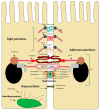Leaky Gut and the Ingredients That Help Treat It: A Review
- PMID: 36677677
- PMCID: PMC9862683
- DOI: 10.3390/molecules28020619
Leaky Gut and the Ingredients That Help Treat It: A Review
Abstract
The human body is in daily contact with potentially toxic and infectious substances in the gastrointestinal tract (GIT). The GIT has the most significant load of antigens. The GIT can protect the intestinal integrity by allowing the passage of beneficial agents and blocking the path of harmful substances. Under normal conditions, a healthy intestinal barrier prevents toxic elements from entering the blood stream. However, factors such as stress, an unhealthy diet, excessive alcohol, antibiotics, and drug consumption can compromise the composition of the intestinal microbiota and the homeostasis of the intestinal barrier function of the intestine, leading to increased intestinal permeability. Intestinal hyperpermeability can allow the entry of harmful agents through the junctions of the intestinal epithelium, which pass into the bloodstream and affect various organs and systems. Thus, leaky gut syndrome and intestinal barrier dysfunction are associated with intestinal diseases, such as inflammatory bowel disease and irritable bowel syndrome, as well as extra-intestinal diseases, including heart diseases, obesity, type 1 diabetes mellitus, and celiac disease. Given the relationship between intestinal permeability and numerous conditions, it is convenient to seek an excellent strategy to avoid or reduce the increase in intestinal permeability. The impact of dietary nutrients on barrier function can be crucial for designing new strategies for patients with the pathogenesis of leaky gut-related diseases associated with epithelial barrier dysfunctions. In this review article, the role of functional ingredients is suggested as mediators of leaky gut-related disorders.
Keywords: health; ingredients; leaky gut.
Conflict of interest statement
The authors declare no conflict of interest.
Figures






References
Publication types
MeSH terms
LinkOut - more resources
Full Text Sources

